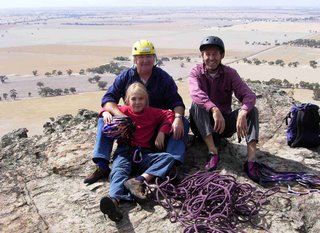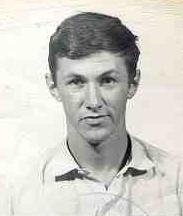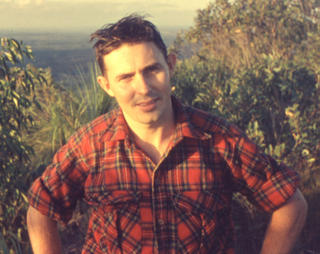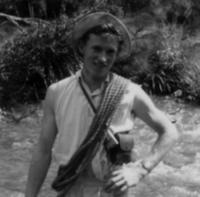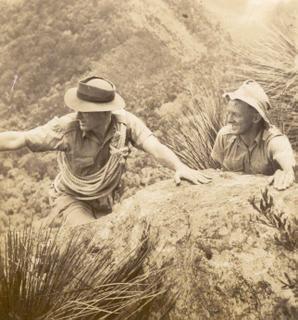Ghosts and The Glass Houses
The 300 metre high peak, Crookneck, in the Glass House Mountains north
of Brisbane was one of the last summits in Australia to be claimed by
Europeans. In 1886, Queensland explorer and climber Thomas Welsby described ‘a
great falling away of stone’ on the east face of the mountain. Seven years
later in 1893, the Royal Society of Queensland heard details of another
landslide revealing ‘a huge fissure’ following a sustained period of heavy rain
that caused massive flooding in Brisbane. And so the climb known today known as
East Crookneck was born.
But it would be more than half a century before climbers seriously considered
the east face as a possible ascent route.
The
mountain, called Coonowrin by the Kabi Kabi people, has always been
an object of fascination for Europeans. Towards the end of the 19th
century, speculation on the possibility of someone climbing the peak was
rife with
one local sage insisting: ‘It has always been said by old bushmen that
Crookneck cannot be surmounted.’ Another scribe in 1885 made a bold
prediction—curiously accurate, as it turned out: ‘I don’t doubt that
when the
railway makes these [mountains] within reach of the Brisbane tourist,
many will
try then ascend, but without engineering skill being brought to help it
will
not be done.’ Pragmatic local explorer William Landsborough simply
reminded them
that if the mountain was in England ‘it would have been climbed a dozen
times’.

But it wasn’t until 1910 that 23-year-old local lad Henry Mikalsen (pictured above) made
the first ascent, solo, up the treacherous, loose north face. ‘The feat was not
accomplished without difficulty and danger,’ the Brisbane Courier reported. ’The trip took about three hours from
start to finish, and as his home is at the foot of the mountain, he was watched
with anxious eyes and could be seen the whole time.’ Pioneer climber Bert
Salmon always referred to this first ascent of Crookneck as the birth
of modern climbing in Australia.

Two years later, on Empire Day 1912, three sisters—Jenny, Sara and Etty
Clark—became the first women to reach the elusive summit, climbing a new route
on the southern side now known as Clark’s
Gully. It is one of the earliest recorded instances in Australia of the now
accepted technique of belaying. One of the Clark sisters tested out the system
unexpectedly, as this account of the climb suggests: ‘As she stepped off onto
another little corner the rock gave way and left her swinging for a moment in
mid-air, some 100 ft above the ground. Fortunately, the rope was good, and in
strong hands, and she soon gained a fresh foothold and she soon clambered into
safety.’ Etty Clark managed to get halfway up the climb, 36 years later, observing:
‘When I climbed to the top…we girls took off our skirts and finished the climb
in knee-length bloomers. They didn’t have shorts in those days.’
In the early 1920s, Philip Webster and his brothers, Tom, George and the
‘partially handicapped’ Norman, found a new climb on the south side of
Crookneck which follows most of the existing Salmon’s Leap or tourist route. Strangely, this is the only
climbing route in southeast Queensland bearing Salmon’s name, but it is one he
never claimed. During the 1930s, with climbing booming in southeast Queensland,
Crookneck was one of the favoured destinations. On one trip in September 1934, Salmon
took a record group of 26 people up the mountain, encouraged by the
irrepressible George Fraser playing ‘Highland airs’ on his bagpipes from the
summit! Around this time, Salmon and another 30’s stalwart, Cliff Wilson, made
an extraordinary first descent of
west Crookneck.
The first serious attempts to climb the east face began in 1950 when Bob
Waring and another University of Queensland student, Jim Gadalof, abseiled down
the fiercely overhanging route. They had no abseil devices—not even a
carabiner—adopting the classic method for the painful 75 metre descent. Waring
discussed the possibility of climbing the face with John Comino, a co-founder
of the University of Queensland Bushwalking Club (UQBWC). Comino abseiled down
to a small ledge, dubbed the ‘Eagle’s Eyrie’, and climbed what would eventually
be the last pitch of the route. But the real problem was what lay below.
This was the challenge for university
physics student Ron Cox who began his drawn-out project to climb the face in
June 1959. Cox read Guido Magnone’s 1955 book, The West face of the Dru,
and was inspired to apply the same techniques. ‘That was the great era of
artificial climbing in the Alps,’ Cox recalls, ‘and reading that and other
books and magazines I became very interested in artificial climbing which had
its apogee at that time. So that’s how we started doing that sort of thing.’ He
teamed up with UQBWC friend Pat Conaghan and the two set about making their own
gear for an attempt on East Crookneck—etriers and wooden wedges in Cox’s
father’s furniture factory, and pitons cut from steel plate. Cox recalls the
pitons were flat with no wedge: ‘I remember on one occasion going to a guy who
had a little forge in Margaret Street—unimaginable now—and I gave him some of
these pitons and got him to hammer a taper into them. I remember using one of
these on East Crookneck and the head snapped straight off!’
 |
Ron Cox engaged in the assault on the east face of Crookneck,
The Glass House Mountains, 1959 (Pat Conaghan collection). |
Cox found ‘great piles of
ironmongery sitting at the foot of the cliff—big spikes, 30 cms long’— perhaps evidence
of previous attempts. Climbing on weekends and belayed by a range of partners,
Cox slowly advanced up the route over the next three months. ‘It was vertical: that’s
the essential thing’, he recalls. ‘And in a sense, to that point in Queensland,
we were climbing things that weren’t vertical that had a bit of a slope.’ It
was arguably the first serious application of double rope, aid climbing
techniques in the country. Although he had adopted the European approach, he still
imposed ethical limits, rejecting the use of bolts ‘because they made anything
possible’.
Cox had quickly established himself as one of the best—and
safest—climbers in the Brisbane-based cohort and had already made his mark on
the cliffs at Kangaroo Point, climbing the route now known as Cox’s Overhang
on a top rope, early in 1959. Described by Comino as ‘built like a bloody
spider’, Cox was one of the few at that time who could climb the overhang free.
The climb was probably the hardest in Queensland. Comino remembers being
impressed by Cox climbing the route and then being challenged to have a go
himself—on a top rope: ‘Anyway I got up there and after that I think Ron
thought, “Well, this fellow can climb” and that’s probably what caused him to
look me up about Crookneck some time later.’
 |
| Pat Conaghan bivvying during the first ascent of the east face of Crookneck in 1959 (Pat Conaghan collection). |
Following his
7th attempt on East Crookneck and with just 25 metres of the route left, Cox decided
it was time for a first ascent push. He asked Comino to come out of retirement
to join Conaghan and himself and the trio gathered below the face on 18
September. Cox reached his previous high point in about three hours and called
for Comino to follow. Conaghan described the experience in the 1960 edition of
the UQBWC magazine, Heybob: ‘Comino
had not climbed artificially and for a while was floundering in the
technicalities. Adjectival phrases floated down consistently and at one stage,
having already discarded his hat, he threatened to throw his etriers away too.
He was soon, however, heard quietly praising the possibilities and efficiency of
these mechanical contrivances and by late afternoon had joined Ron on the
ledge.’ The stance was just big enough for two people and with the light
fading, Cox and Comino set up a bivvy. ‘I retired to my own little protected
ledge under a large roof near the start of the climb,’ Conaghan recalls.
‘During the night, heavy showers of rain carried by a N-W wind fell. I wondered
if the boys were getting wet on top.’
Cox began climbing the final
pitch at 11.00 am the next morning, as Conaghan describes it: ‘First up the crack,
then out onto the wall, then back into the crack again. A piton here and there
was needed but progress was fairly quick for this face—25 feet an hour. So the
gap between Ron and the top narrowed.’ Conaghan dozed and was woken at 1.30 pm by
the sound of some big blocks crashing down as Cox cleaned out the exit chimney.
He crawled onto the summit ridge at 1.55 pm.
In these pre-jumar days, it was
almost dark by the time Conaghan reached Comino on the last stance and with a
torch dangling around his neck, Conaghan kept climbing: ‘Ron yelled directions
from above—where to look for the next piton, or find essential holds. A flash
of my torch would reveal the route for the next few feet, then followed moments
of fumbling for holds as the torchlight danced fitfully, at waist level.’
Conaghan recalls the moment he reached Cox on the summit ridge: ‘A cold wind
was blowing on top and the night was crystal clear. Stars sparkled brilliantly
and a full moon was just rising from the ocean.’ Comino, ‘festooned in a tangle
of rope, etriers, wedges and links’, soon joined them and they scrambled up the
last 20 metres to the summit together. Their entry in the log book read: ‘First
ascent East Crookneck—8th attempt—40 pitons, 7 wooden wedges—last
man up at 8.30 pm.’ Conaghan recalls they had some trouble finding the path
down Salmon’s Leap but there was
another reward on the descent: ‘A huge gleaming mass stood out against the
western sky. It was Beerwah, lit by a silver moon.’
Despite the epic nature of the climb,
it was a significant achievement, although Cox remains circumspect about its
impact: ‘I felt very elated doing it and very embarrassed in retrospect at not
having done it cleanly at all. I guess I could have done it more cleanly but at
the time we were not aware of purer forms of climbing. We just went up and
looked at it. I would say I learned to climb on East Crookneck which is not the
ideal place to learn to climb. Since we couldn’t climb very well we took a long
time to get up.’ In 1961, Cox repeated the route with Peter Hardy, a member of
Rhum Dhu, a radical offshoot of the Sydney Rockclimbing Club. On a top rope,
Hardy managed to climb much of the second pitch free using the chimney, rather
than following Cox’s original peg line on the left hand wall.
But it remained essentially an
aid route until expatriate British climber Les Wood’s visit to Queensland in
1966. His impact on raising standards in Australia at that time was similar to
that of a young Sydney-based climber called John Ewbank. One of Wood’s first Queensland
targets was East Crookneck, urged on by his close friend and climbing partner,
Donn Groom. ‘We found most of it could be climbed free and that the etriers
were necessary in one place,’ Wood recalls, consulting his diary. ‘The last
pitch was done in very heavy rain. Three and a quarter hours. A good route. I
remember Donn saying that he thought this was one of the big challenges in the
Glasshouse Mountains.’
The last aid move on the climb—at
a huge bell-shaped overhang—was eliminated by an energetic Greg Sheard and
Chris Meadows in 1969. But another challenge has loomed: five years ago all
climbing on Crookneck was officially banned—allegedly for ‘safety’ reasons. But
strangely, voices can still occasionally be heard drifting down from the
heights on Crookneck—perhaps those of the ghosts of climbers past, determined
to keep alive the spirit of adventure on this memorable crag.
(First published in the Australasian Climbing Journal, Crux Number 2)













